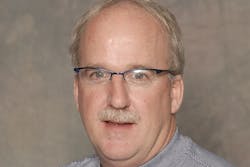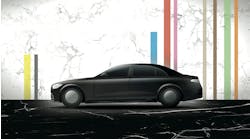Jim Berkey, who has been with PPG for 30 years, joined the company’s Automotive Refinish business division in 2005. It was there that he and his team put their Lean Six Sigma expertise to work on collision repair processes by marrying some of PPG’s Lean Six Sigma resources with its existing MVP Program resources. In the four-plus years since, more than 900 people from 250 shops have gone through PPG’s Green Belt training program.
Berkey is an MVP Master Black Belt Consultant. He has an undergraduate degree in engineering and an MBA. In his position with PPG Refinish, he’s in charge of strategic planning and development for the MVP Business Solutions Group and its CertifiedFirst Network. FenderBender recently caught Berkey between seminars to ask him about industry consolidation, cycle time and the hard truth about survival among the leanest.
What inspired the creation of the PPG MVP program?
PPG’s MVP program has been serving collision repair centers with value added programs for nearly 20 years. The mission has always been to bring solutions to customers that drive performance improvement. In anticipation of industry consolidation five years ago, we started rebuilding our programs. It was very evident that the industry was going to demand stronger performance around quality cost and speed. It was not going to be good enough for customers to just feel good about the training they receive and feel good about their paint supplier. It was going to take real performance improvement to develop a competitive advantage and thrive on the changes that were coming. So we decided that every minute we have with our customers was going to be focused on serious work around performance improvement.
Sounds like you make your clients work hard.
Cycle time reduction was evolving as the latest and most challenging metric in the industry. So our mission was to give people enough understanding about what really drives cycle time in collision centers so that they could be effective in solving problems and developing solutions on their own.
What kind of experience do shops have in your program?
It is comprehensive and intense, no doubt. A bit of a boot camp. But the feedback from participants is that it is life-changing. It provides a good baseline of knowledge and practical solutions to allow shops to get started in the improvement process. We have never tried to push people into this system. This is hard work; it’s not like a typical training class.
Your mission is to provide collision centers with whatever they need to stay in business these days. What does that tend to include?
Four to five years ago, most major insurers were talking about and actually revamping their DRP programs. In many cases this meant reducing the number of participant shops within the programs. As an example, State Farm has decreased its number of DRPs from around 20,000 to somewhere around 11,000. It’s just getting more competitive. Shops must work on performance if they want to be one of those shops in competitive programs.
For PPG, the term “interdependent success” is much more than a buzz word. We don’t want to see even one of our shops go out of business. We also do not want to see them lose a $500,000 DRP contract because of under-performance. For us it’s a loss of paint sales, so we got tougher on ourselves. We have to work even harder on things that help shops improve their performance. When this snowball started rolling many shops were adapting early. Frankly, they’re the ones that have created the largest gap in their cycle time. Today we’re seeing more and more people realize that this is here to stay.
Does the collision repair industry really understand lean processes?
We’ve found research that says that in any significant change process, about 90 percent know what’s wrong with their operations. About 40 percent know what to change to, and about 15 percent can actually make the change. Even fewer can sustain it. I think most in collision know what is wrong. Our challenge is to enable shops to be more successful in making and sustaining these changes than their competitors.
Why is this process so hard for shop operators to implement?
What we do is meant to help get shops out of two failure modes. You look on the Web. There’s lots of stuff available on Lean Six Sigma. If you Google Lean Six Sigma you will get millions of hits. There’s no shortage of data. There are plenty of consultants. There’s all this information, and that’s actually a failure mode: overload. Where do I start?
The other failure mode is the attempt at the quick fix. Someone might visit a friend’s shop and see them using some kind of equipment, or some physical sign that something is different. Then they go buy 50 of them and try to put them to use. They don’t understand the culture change or the processes behind the physical part, but they go back to their shop and try to copy a best practice. It ends up failing the first time they hit a speed bump.
Your program focuses heavily on cycle time.
Shops can’t really differentiate themselves by repairing a car much better than the competition. A way to differentiate today is to do things faster with less waste. Today both consumers and insurance DRP partners realize they can have things they want faster, in less cycle time. For the consumer, it’s a better repair experience. For the insurer, it translates to lower cost and retention of the policy holder. So the emphasis on cycle time is simply a reaction to the expectation in the market.
You’re not the only one focused on cycle time: Insurance companies are, too.
We see both insurance companies and shops working toward cycle time reduction. I think at a corporate level most of the insurance companies are going through a learning process and some adjustments themselves. We’re seeing many instances where shops and insurance companies are working together to eliminate waste. It’s safe to say that in the past the relationship between shops and insurance companies has been tenuous at times. I’ve heard it described as guarded trust.
Typically any supply chain improvement starts with individual businesses. Then they realize that there is another level of performance possible when businesses work together to eliminate waste that is created by the way the two businesses work with each other. In the collision repair industry there is an amount shops can do to fix their own processes and an amount that the insurance companies can do as well. If they are working more closely as real partners they can get even more of the waste taken out of the system.
We’re trying to get shops to understand that the next decade is not going to be like the past several decades have been. Five years ago, about 63 percent of collision repair work was influenced by the top 10 insurance companies. That’s up to 68 percent today. Every time we ask shops whether or not they feel insurance company influence will grow the response is that it will grow. If we assume that’s the case, learning to work more effectively together makes sense.
So if shops want to improve their cycle time, where should they start?
We start with Little’s Law, which dictates what drives cycle time in any process. We ask people to think about a funnel, and to imagine putting marbles through it. What affects the amount of time—or cycle time—that it takes to get the next marble I throw into the top of the funnel out of the bottom? First is the size of the opening of the funnel, which controls how fast things come out. This is the output rate. The second thing is the amount of marbles already in the funnel. If the funnel is full it means a longer time to get the next one out. If the funnel is empty, the next one we throw in comes out more quickly. This represents the “work-in-process” inventory.
A collision center works the same way. It has an output rate. The output rate—or cars per day—is dependent on the resources the shop has to get work done. A collision center process also has work-in-process inventory. And the more inventory the shop has, the longer it takes to get the next car through.
Think about going to your favorite restaurant on a Friday night, and you’re hungry, and you find that the restaurant is very crowded and there’s a long wait to get a table. You’re likely going to leave because intuitively you know it is going to take a long time to get a table. When you see a crowd of people waiting, it represents too much inventory already in the system. We use Little’s Law daily without even knowing it.
Okay, what do marbles and Friday night pizza have to do with collision repair?
In the past it was a good thing to have a very large backlog of work at the shop. It made us feel secure about having work. It’s a natural feeling. Now let’s picture a shop that has 50 cars in process sitting on the premises. This same shop may have seven technicians. How many cars can one technician touch at once? That’s right, one! So we have 43 cars sitting untouched while we are actually touching maybe seven. The more cars we have in process, relative to the number of cars we can touch or finish in a day, just drives up cycle time. So at some point the very cars that have been making us feel secure can make us less competitive.
It does sound counterintuitive: Fewer cars equal more business.
It is counterintuitive. And let me clarify, we are not saying we will complete fewer cars. On the contrary we expect to complete as many or more as before. We just want to get better at working on fewer at one time and having fewer idle cars in the system not being worked on. We like shops to get their arms around this idea. It’s simple but it is also a big change.
Sounds like you’re talking about a paradigm shift in the way people think about success in this industry.
Exactly right. Prior success in the old model can actually slow people down when it comes to thinking about new ways to do things. You have to solve problems in the new paradigm in a different way. Any of us who have been successful doing something a certain way for a long time run the risk of hanging onto traditional ways too long when the model or the paradigm changes. Today, those who are most responsive to change will survive. Today it is about quality cost and speed.




